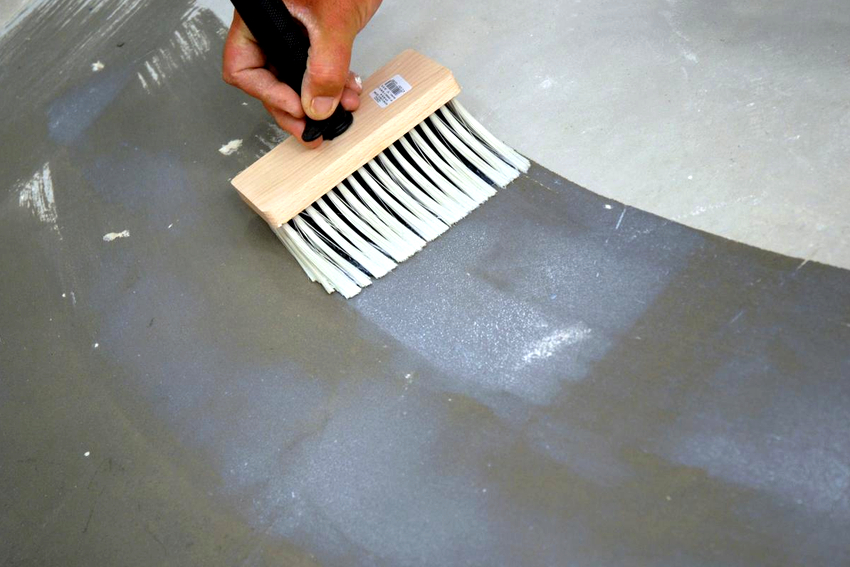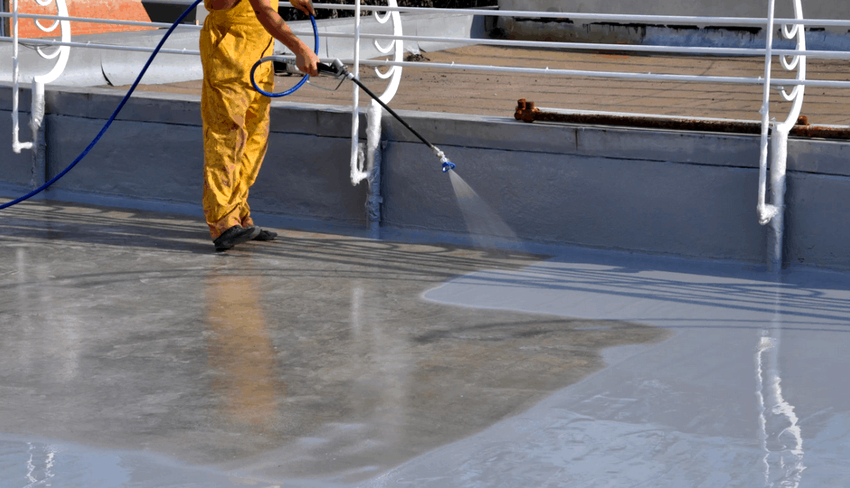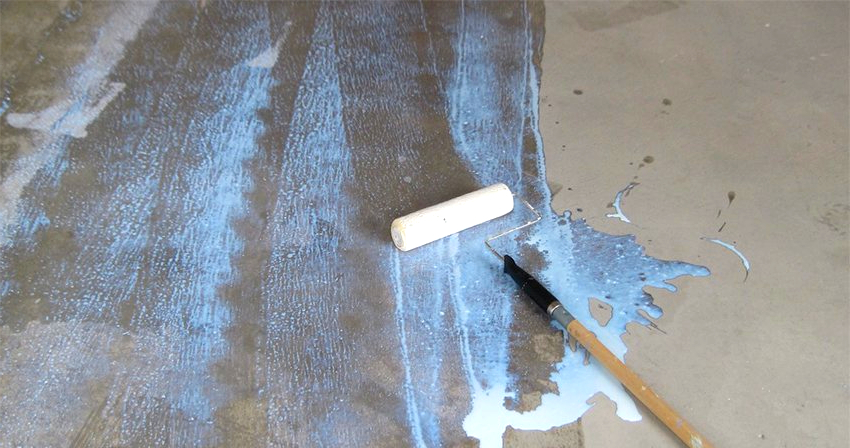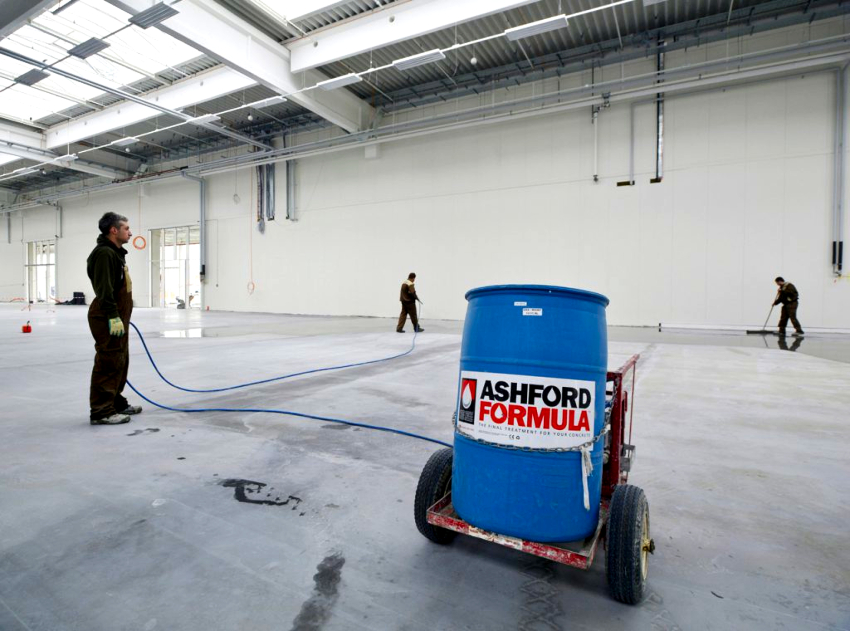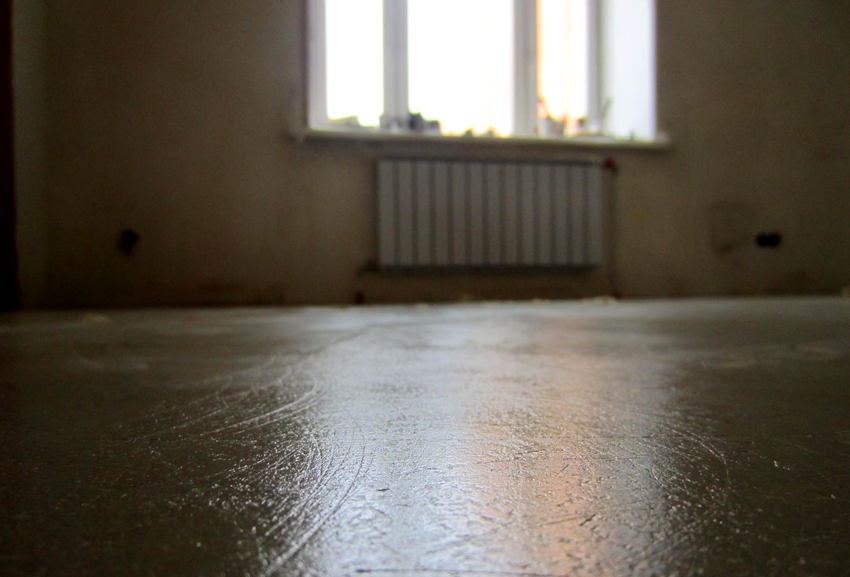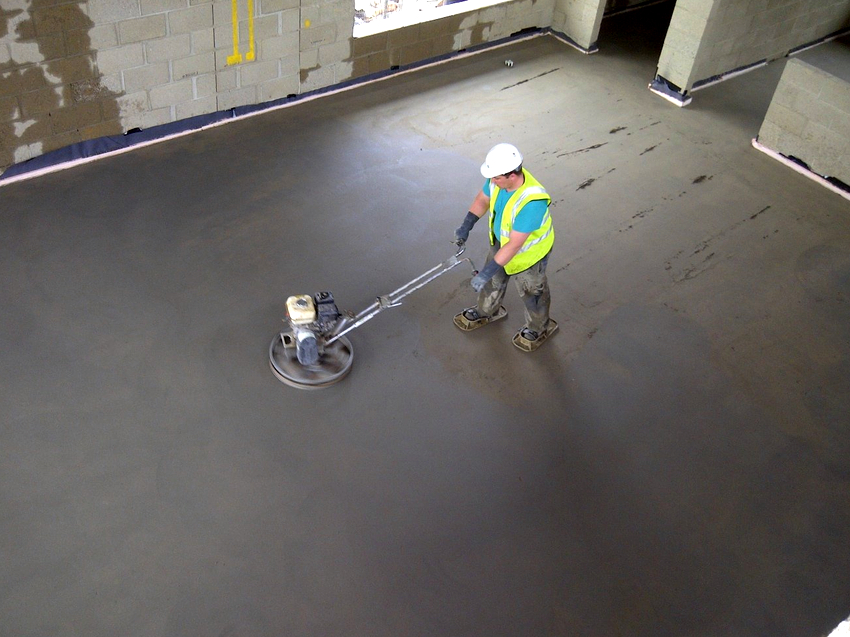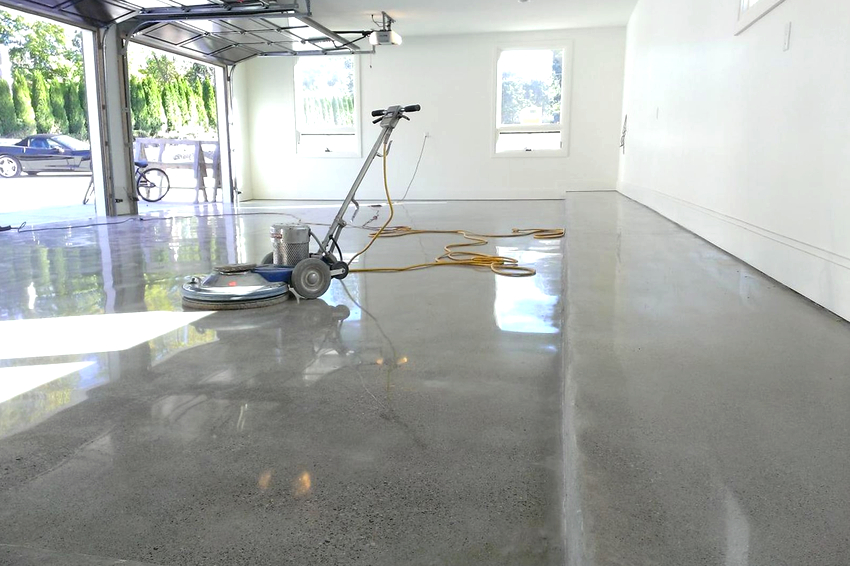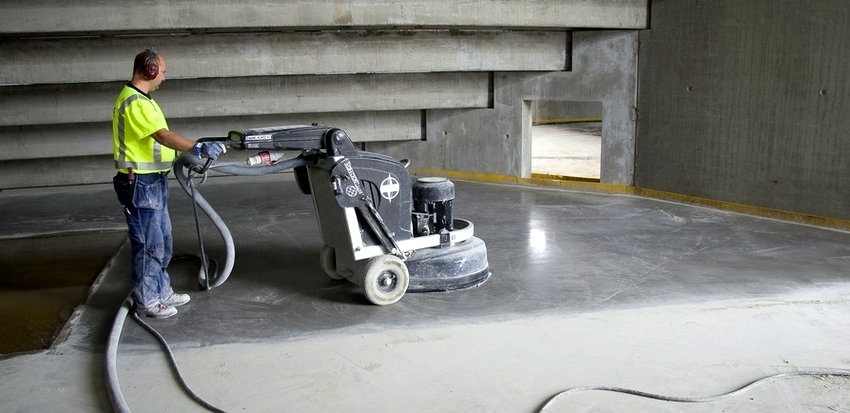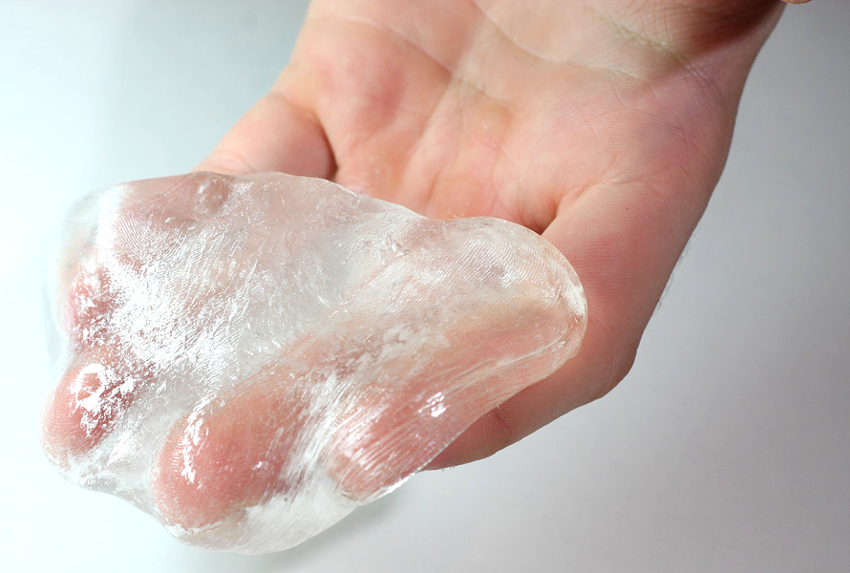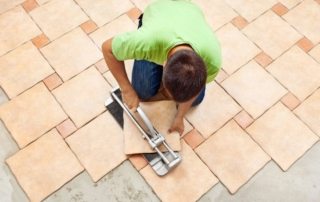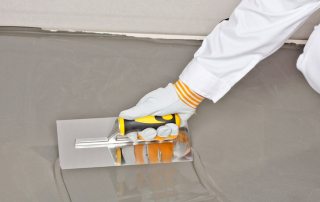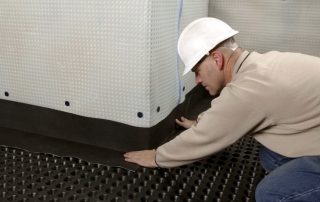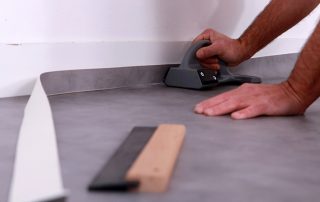A well-made concrete floor is a solid, reliable and durable base. However, this surface is not without its drawbacks. The main one is the formation of a large amount of dust during operation, which negatively affects human health, the operation of equipment and mechanisms. Dedusting the concrete floor will help to eliminate such a problem, the methods of implementation of which can be found in this article.

During the operation of the concrete base, a large amount of dust appears, the problem is solved by dedusting the floor with special impregnations
Content [Hide]
- 1 Reasons for the formation of concrete dust
- 2 Why is concrete floor dedusting performed?
- 3 How to cover the concrete floor so that it does not dust in a garage or other room
- 4 How to cover a concrete screed so as not to get dusty: features of topping compositions
- 5 How to treat a concrete floor so that it does not become dusty: characteristics of special impregnations
- 6 Surface dedusting technology using impregnation
- 7 How to remove concrete dust: the method of grinding and polishing the surface
- 8 How to treat a cement floor so that it does not get dusty: using liquid glass
Reasons for the formation of concrete dust
The cause of dust on the surface of a concrete floor is related to the erosion of its top layer. The structural structure of hardened concrete is represented by a pronounced conglomerate mixture, which contains dissimilar components. They differ not only in size, but also in chemical composition. The maturation process of cement stone consists in the formation of a silicate crystal lattice. It intersects with coarse-grained insoluble fillers of gravel and sand origin.
Concrete is made up of many microscopic and large pores that are filled with air, water and a gelatinous cementitious substance. There are also unbound chemically active substances that are the cause of erosion processes in the upper layers of concrete. This occurs with constant mechanical action on the concrete surface, the upper porous layer of which begins to collapse. Unbound particles of cement and chemically active substances turn into dust.
In addition, in the process of concrete maturation, cement milk is released to the surface. When solidified, it forms a weakened layer that is often the main source of dust.
To prevent the concrete floor from dusting, it is necessary to reinforce it, bind the top layer with a polymer mesh, crystalline components, or completely remove the upper unstable surface. For this, there are three methods of dedusting the surface. This is the strengthening of the base using topping, treatment of the coating with special impregnations and sanding the floor.
Important! The best result is obtained by the integrated application of all technologies for dedusting the concrete surface.
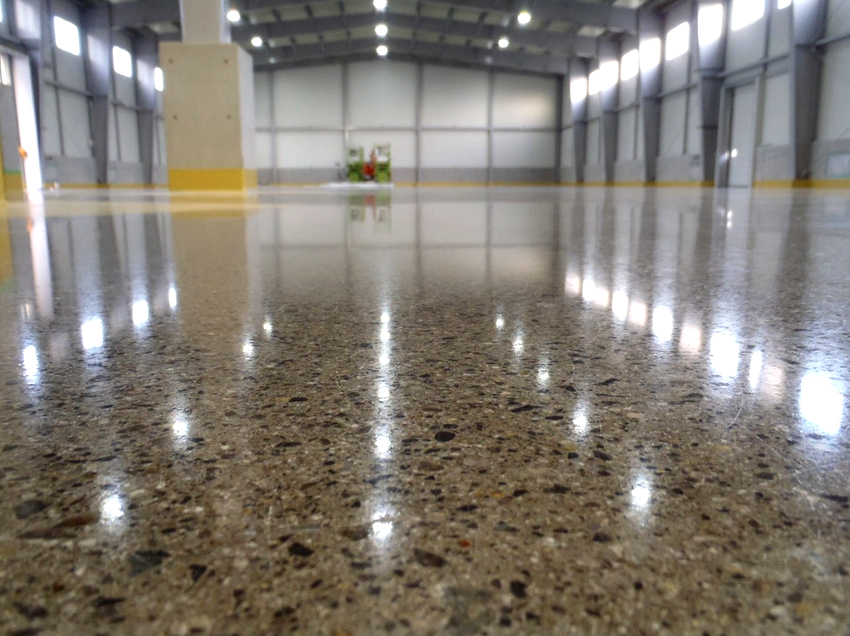
To dust the concrete floor, you can use grinding, hardening with topping, processing with special impregnations
Why is concrete floor dedusting performed?
Dedusting is the hardening of a concrete pavement using toppings, impregnations or grinding, which is carried out to extend the period of its reliable operation.
If surface erosion processes are not stopped in time, they will eventually affect deeper layers of concrete. This can lead to not only partial, but also complete destruction of the screed.
Cement dust, which forms on the surface, negatively affects human health. Tiny particles of cement and chemicals enter the eyes and skin, causing itching. Inhalation of substances can provoke respiratory diseases and cause allergic reactions.
When the concrete floor is dusty, equipped in workshops, garages, warehouses, the dust has a negative impact on the well-coordinated operation of the equipment and mechanisms installed here. This will lead to rapid wear of the tool and units, which will soon fail. A crumbling concrete floor needs constant cleaning - otherwise it will have a sloppy and untidy appearance.
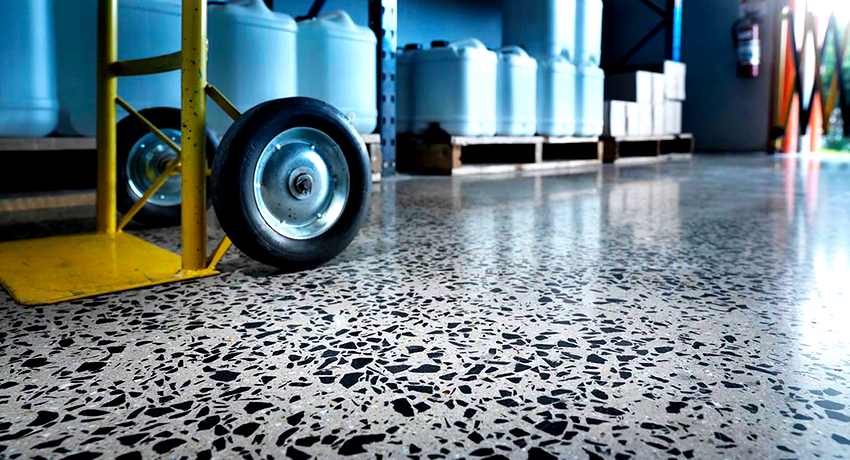
Dedusting the concrete pavement not only prolongs the service life, but also improves its aesthetic appearance
If the concrete floor is used as a sub-base, even in this case, the surface should be dedusted. If this is not done, over time, the coating will begin to crunch and squeak, which will provide inconvenience when using the surface.
How to cover the concrete floor so that it does not dust in a garage or other room
The destruction of the upper unstable concrete layer leads to the constant formation of dust on the base. You cannot get rid of it at once, sweeping it from the surface, since the next layer begins to collapse. It is best to eliminate such a problem at the stage of curing the concrete screed, which is fixed with special compounds for dedusting the concrete floor, which strengthen the surface and prevent its destruction throughout the entire period of operation.
To prevent the concrete from dusting, as well as to increase its strength characteristics, toppings and impregnations are used. Such hardeners penetrate deeply into the pores of concrete, clogging them, blocking the path of formation and removal of dust. Such sealing makes it possible to exclude not only the process of leaching of concrete, but also the destruction of its thickness as a result of exposure to moisture and chemicals that can penetrate into it.
Dust-free floors are characterized by increased strength, endurance, wear resistance, moisture resistance, the ability to withstand any stress and intense impact. Concrete bases with a hardened surface have an aesthetic appearance, which is achieved thanks to a smooth, even and tinted surface if necessary.
How to cover a concrete screed so as not to get dusty: features of topping compositions
When deciding how to cover the concrete floor so as not to get dusty, you should pay attention to the innovative technology in the form of topping. This protective mixture consists of Portland cement, mineral additives, plasticizers and dyes.The first component serves to bond all elements of the mixture, which contributes to the effective filling of concrete pores, adhesion to the coating, excluding material flaking.
Topping provides increased strength, durability of the concrete floor. Such a protective composition excludes the penetration of moisture into the thickness of the concrete, which can cause the destruction of its structure with subsequent leaching of the surface. A floor with a topping coating withstands the effects of chemical components, therefore it can be safely used in garages, production halls and workshops.
The composition penetrates deeply into the pores of concrete, clogging them, as a result of which the period of operation of the coating is extended, which does not collapse from mechanical stress and other negative influences. Such a means for dedusting a concrete floor has an acceptable cost, which allows an inexpensive hardening of the coating. To a greater extent, the process can be reduced in price when using low grades of cement to create a floor, the disadvantages of which can be compensated for with an ultra-strong protective compound.
Topping is available in dry powder or liquid form. The powder is evenly scattered onto the surface, then compacted and sanded. Seams will form on the concrete floor when dry matter is used. This is a budget topping option. The liquid composition is evenly applied to the surface, forming a strong and reliable protective film that is resistant to moisture and chemical compounds. It turns out to be uniform, even and smooth.
Varieties of topping concrete floor covering from dust
Modern topping is presented in three compositions: quartz, corundum and metallized. For rooms with medium intensity of use, a composition based on quartz sand is used. This mixture not only provides dedusting and hardening of the concrete surface, but also gives it an attractive appearance due to the presence of coloring pigments in its composition.
Quartz topping is suitable for arranging flooring in residential buildings, educational institutions, warehouses. Another advantage of this option is the acceptable cost of the composition.
How to process concrete so that it does not get dusty in rooms where heavy equipment is located, there is heavy traffic of vehicles and people? In these cases, it is better to use corundum topping, which contains a mineral additive in the form of corundum chips. This coating is characterized by high strength, wear resistance, abrasion resistance, moisture and aggressive chemical compounds.
The most reliable hardener is metallized topping, which is made on the basis of metal shavings. It provides effective dedusting of the floor, which will maintain the integrity of the structure for many years. In addition, this topping increases the strength characteristics of the concrete surface by 2.5 times.
It is advisable to use such a composition in rooms with increased vibration, where massive heavy equipment is installed, which requires constant movement of heavy equipment. The disadvantage of metallized topping is the high cost of the composition.
How to remove dust from a concrete floor: arranging a topping coating
How to treat the concrete floor so that it does not get dusty in the garage, workshop, production, warehouse, public or residential area? The most correct solution is to arrange a topping coating. The composition can be presented in dry or liquid form, which determines the technology of its application.
The liquid mixture is applied to fresh concrete screed or old floors. The first step is to prepare the surface.It should be cleaned, all existing defects repaired and sanded. The topping is applied to the floor using a spray gun or roller. The layer thickness is 2-3 mm. The mixture is quickly absorbed and hardens.
The dry composition is evenly distributed over the entire surface area 5-6 hours after pouring the concrete screed. The process is carried out using a dosing cart. 2/3 of the total volume of the material is applied immediately. The composition begins to interact with moisture. Thus, the crystallization process takes place. The complete and uniform darkening of the entire surface indicates the completion of the reaction. It's time to grout the base with a sander. When the rubbing of the mixture is over, you should wait until the surface sets.
Important! To obtain a high-quality base, it is important to saturate the topping with cement milk as much as possible, without overdrying the surface, while additionally moistening it with water is strictly prohibited.
The next step in dust-free concrete flooring is to apply the rest of the material. After 48 hours, the surface is cleaned using paddle knives. The procedure is performed in several steps until a smooth, mirror-like base is achieved.
The final process is the application of the solution in the form of curing, which eliminates the likelihood of moisture evaporation from the concrete. The material is spread over the surface using a roller or spray. At the end of the process, expansion joints are cut to prevent cracking of the concrete floor when the base hardens. Seams are filled with sealant. The cost of dedusting concrete using topping starts from 1000 rubles /m².
How to treat a concrete floor so that it does not become dusty: characteristics of special impregnations
To do the dedusting of the concrete floor with your own hands, special liquid impregnations on an organic or inorganic basis can be used. They penetrate deeply into the concrete, forming a strong and reliable connection. Organic impregnations are presented in several varieties, namely in the form of epoxy, polyurethane, acrylic composition.
The polyurethane mixture not only contributes to the dedusting of the floor, but also performs a complete sealing of the base, which entails an increase in the strength, wear-resistant, shock-resistant and chemically resistant indicators of the surface. If it is used for dedusting concrete M350 (and more), the required penetration depth of impregnation is 2-3 mm, and for compositions M150-M350 this value increases to 5 mm.
Important! The polyurethane mixture has a strong unpleasant odor, therefore it is recommended for use as an impregnation for concrete outdoors.
The epoxy mixture is produced completely odorless. It is represented by a two-component composition based on epoxy resins. Such impregnation ensures the creation of a strong, reliable, moisture-resistant, frost-resistant, durable base, which is highly hygienic. The disadvantages of such a mixture include its high cost.
Acrylic impregnation is preferable for surfaces that do not take strong mechanical stress. It is used for concrete grade M200 (and more). Such a dust-free and hardened base will be characterized by increased moisture resistance and high hygiene.
Inorganic mixtures are represented by fluates, which include sodium, potassium and lithium polysilicate compounds.The impregnation penetrates deeply into the porous structure of concrete, causing chemical reactions in its upper layer that last up to 15 days. This leads to the formation of insoluble, crystalline glassy bonds that clog the pores, hardening and dusting the surface.
Important! Any impregnation may contain a coloring pigment to give the finished coating a more attractive appearance.
Surface dedusting technology using impregnation
Before applying the impregnation to the concrete, the floor must be sanded. This is done in order to remove the top destroyed layer, cement laitance, traces of dirt and oils, at the same time leveling the surface.
Related article:
Liquid glass for waterproofing: reliable protection against moisture
Water-repellent material characteristics. Application of the product at various facilities. The order of work and the rules for preparing the solution
Sanding can be done on a damp or dry surface. The latter option is distinguished by high productivity and the ability to control the process. The moistened grinding method produces a well-polished surface.
Important! Grinding the floor with a grinding machine helps open the pores of the concrete base, which improves the efficiency of penetration of the composition into the surface thickness and forms stable chemical compounds.
Any impregnation is applied using a fluffy roller, brush or spray. The composition is poured onto the prepared base in strips. Ensure that the entire surface area is filled evenly. There should be no places where the composition quickly absorbed into the concrete, zones with minimal saturation, where puddles have formed. The inorganic composition is applied in one layer.
The base must be coated twice with polymer impregnations. The composition is evenly spread over the surface using a squeegee or silicone roller. After 30-50 minutes, a second layer of the mixture is applied. The surface should dry for 20 minutes. After the time has elapsed, all excess impregnation should be removed with a rag.
After 24 hours, the hardened and dust-free surface can be painted over with polyurethane enamel, which is applied in two layers. After a day, the surface is suitable for use. The price of dedusting a concrete floor using impregnations starts from 800 rubles /m².
Important! The surface dedusted with the help of impregnation is distinguished by several times increased strength, which depends on the quality of the original concrete base.
How to remove concrete dust: the method of grinding and polishing the surface
When deciding what to do so that the concrete floor is not dusty, you can use another technology, which is surface grinding. It can not only precede further surface treatment with toppings and impregnations, as mentioned above, but also be the final stage for preparing the surface for use.
Grinding is done dry or on a damp surface. The first method is in great demand. The grinding process can be monitored visually. In this case, there is no need to wait for the surface to dry. The main disadvantage of this method is the formation of a large amount of dust during work.
Useful advice! To facilitate the dry sanding process, it is recommended to connect a washing vacuum cleaner to the sanding equipment.
Dedusting concrete with a grinder can be carried out on a moistened base, which is mainly used for arranging mosaic floors with granite or marble spraying.The surface is perfectly flat, smooth, close to polished. However, the process is characterized by high labor intensity, low productivity, which is associated with the rapid clogging of abrasive elements with wet sludge, which are difficult to remove in a timely manner.
How to remove construction dust from a concrete floor using a sander
Grinding is carried out with a mosaic grinder, which is a heavy-duty machine equipped with an electric drive. The working part is equipped with one or more rotating discs with corundum or diamond segments, which differ in grain size.
Useful advice! For grinding a small area, they often use a special grinder attachment.
You can dust the concrete floor with a grinder on an old base or on a freshly laid screed. In the latter case, the first stage of the process begins a week after the floor is poured, which will allow removing the formed layer of cement milk, exposing more durable layers. Finishing works are carried out after complete setting of the concrete, which occurs after 28 days.
Surface grinding is carried out in several stages. First of all, it is necessary to remove the loose top layer, which is accompanied by exposure of the filler and preliminary leveling of the surface. On the old base, the sander completely removes the erosional areas of the concrete floor. This stage involves the use of segments with a grain size of 30-40 units.
Subsequently, the base is strengthened with the help of special impregnations. This type of work may not be carried out when sanding the topcoat. The final stage is surface treatment with abrasive segments with a grain size of 100-400 units. for a smooth, even, dust-free floor.
In case of urgent need, the floor surface is polished using diamond segments with a grain size of 1500-3000 units, which makes it possible to obtain a mirror, moisture-resistant, dust-free base.
How to treat a cement floor so that it does not get dusty: using liquid glass
When the question arises of how to treat a concrete floor in a garage or workshop in order to dedust the surface, many tend to use liquid glass. The material is represented by a viscous adhesive solution, which is based on silicate of potassium, sodium and other elements. The composition is made by fusing soda and quartz sand.
Manufacturers produce potassium, sodium and lithium liquid glass. The first option is characterized by good adhesion and interaction with mineral surfaces. As a result of dedusting the concrete floor with liquid glass, a strong, moisture-resistant, fire-resistant base is obtained. This glue has the lowest cost.
Potassium water glass also provides a durable surface that is resistant to moisture, corrosive environments and other negative factors without losing the integrity of the base. This type of composition does not create glare on the surface, therefore it is appreciated when performing outdoor work. The most widespread is lithium liquid glass, which can be used to process a concrete floor of any age, increasing its abrasion resistance by 20-40%.
Liquid glass is applied using flute brushes based on mixed bristles, velor roller or spray gun. The latter option is convenient to use for dedusting the surface of the walls.
Liquid glass is applied to a previously prepared, debris-free, sanded surface. The first portion of the composition is poured onto the base with a layer of 2-3 mm, evenly spreading over the entire surface using a squeegee.The next layer is applied after 3 hours, no more than 3 mm thick. After complete drying, the surface is ready for use. The price of dedusting a concrete floor with liquid glass is 1300-1500 rubles /m².
Dusting the surface is an important and necessary measure to extend the life of the coating. The process of protecting the base can be carried out using special impregnations, toppings, liquid glass, as well as by grinding. Each variant is characterized by distinctive features. However, all of the above dedusting methods provide a solid, reliable, wear-resistant and durable base.

